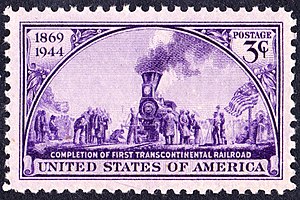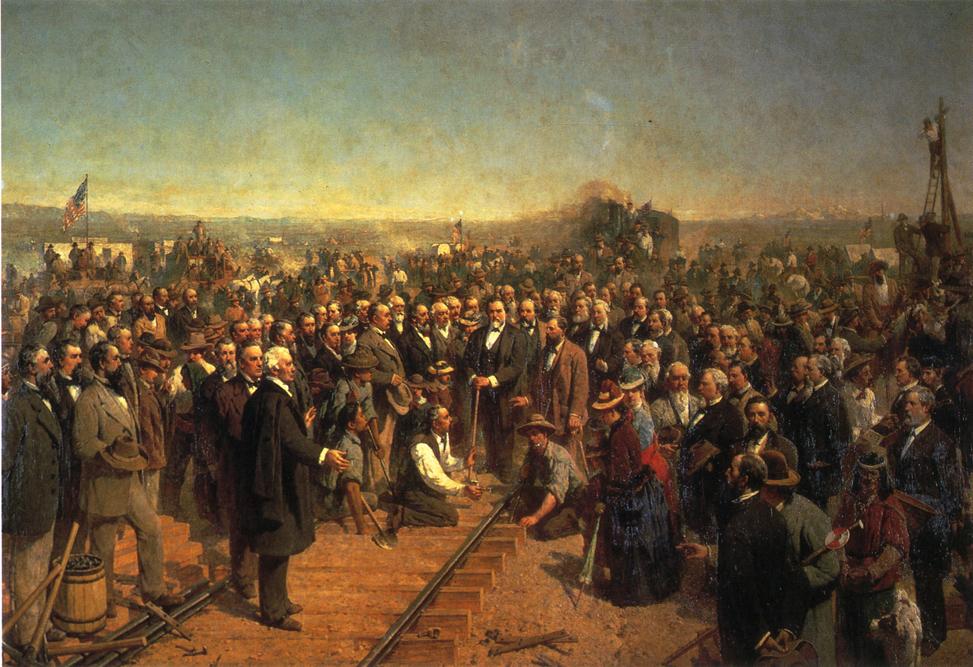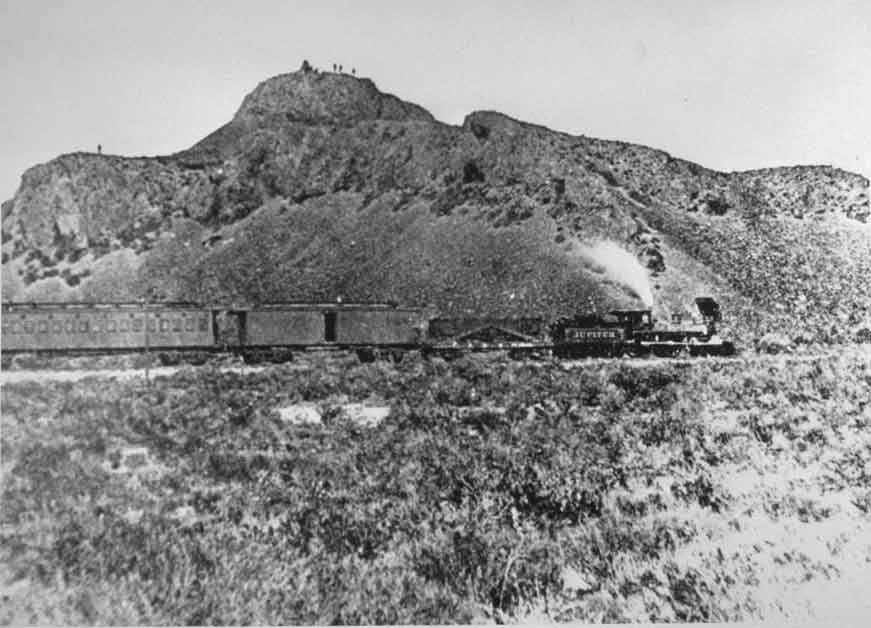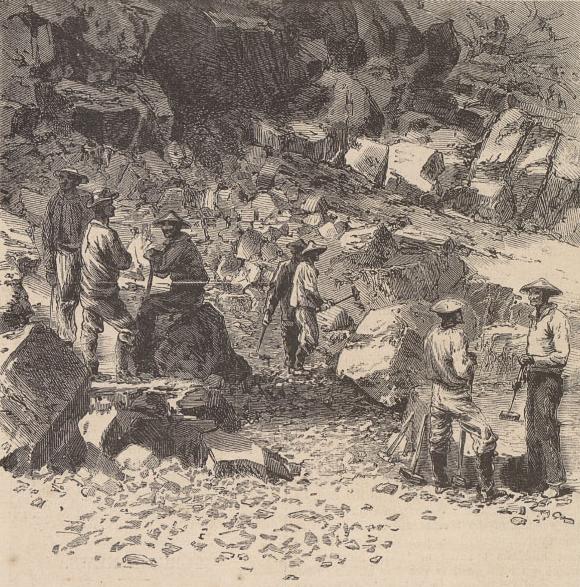Topics on the Page

Summary of the Building of the Railroad
Primary Sources
Video Resources
Chinese Railway Workers
Native Americans
African Americans
Picture Book Text Set about the Transcontinental Railroad
 Cross-Links
Cross-Links
AP US History Key Concept 5.1: Immigration, Migration and National Expansion
Chinese Immigration to the United States
Summary of the Building of the Railroad
For background information, link to Building the Transcontinental Railroad from Digital History

The development of railroads was one of the most important outcomes of the Industrial Revolution.
- The Transcontinental Railroad linked the country. Not only did the railroad transport people, but it also transported a variety of goods, allowing for new markets and resources as well for manifest destiny.
- The railroad was built by the Union Pacific and Central Pacific companies.
- For each mile of track these companies completed, they were rewarded with 640 acres of public land.
- Overall, railroad companies were given about 200 million square acres of land.
- The railroad directors, such as Cornelius Vanderbilt, made their fortunes building the transcontinental railroad.
- They furthered their fortunes by accepting money from public officials and by charging various shipping rates.
Click on Binding the Nation by Rail for more information on the Transcontinental Railroad.
 |
| Engraved cover illustrations from 1881 Timetable and Map |
For an interactive timeline and map on the race to Utah by the Union Pacific and Central Pacific, visit PBS: Race to Utah!.
See also The Story of the First American Transcontinental Railroad from the Union Pacific Railroad Museum
Driving the Last Spike from the Virtual Museum of the City of San Francisco provides an informative overview of figures, like Leland Stanford, responsible for the completion of the transcontinental railroad.
History.com series America: The Story of Us episode aboutThe Transcontinental Railroad shows how the railroad unites the nation and transforms the Heartland and touches upon the decline of Native American civilizations as farmers settle the continent
 Primary Sources
Primary Sources
 |
| The Driving of the Last Spike, painting by Thomas Hill, 1881 |
Excerpt from Diary of Railroad Construction Engineer, 1868
Picture shows the Train That Carried Leland Stanford to the Golden Spike Ceremony.
Stanford Watches from the Hill Above

 Video Resources
Video Resources
Transcontinental Railroad from BBC. This is the first of five parts; the other parts are also available on YouTube.
The Transcontinental Railroad: Uniting the States of America, the third place student entry in the 2010 National History Day competition
from the perspective of a young girl whose father was a Chinese laborer.
See multimedia materials from the Chinese Railroad Workers in North America Project from Stanford University.
The following materials provide a complimentary source to the Stanford's Railroad Project The First Transcontinental Railroad - Spotlight at Stanford
Building the Union Pacific from Wyoming Tales and Trails
Click here for a youtube clip showing the expansion of the railroads from 1830 to the 1990s
Chinese Railway Workers
Timeline: Chinese Railroad Workers in North America Project, Stanford University
 |
| "Chinese Laborers at Work": Harper's Weekly, Vol. 11, 1867 |
The Big Fill in Golden Spike Historical Site

How Chinese Immigrants Helped Build US Railroads:
- Chinese immigrants were absolutely crucial in industrializing and connecting the eastern part of America with the west.
- Prior to the civil war the US had gained a lot of western territory.
- It was the goal of businessmen and civilians alike to better connect the west with the already industrialized east.
- The best way to do this was through the use of a trans-confidential railroad.
- Prior to a railroad if people or goods were hoping to travel from the eastern US to the west then they had two options; They could travel by wagon or they could take a boat around the southern tip of the Americas to reach the west.
- Both trips were long and dangerous so an easier alternative such as the railroad was chosen.
- Those creating the railroads needed cheap reliable laborers in order to take on the massive endeavor.
- Chinese immigrants had flocked to the US for better economic opportunities one of which being the gold rush which was extremely tantalizing to immigrants.
- When the work on the railroad started the immigrants who had not struck it rich yet joined the workforce.
- Overall the railroad in the west was built primarily by Chinese immigrants.
- They faced awful treatment, conditions and pay yet they were instrumental in creating the railroad and connecting the country.
- They received less pay, no free shelter and bad meals while their white co workers received better pay, free shelter and meals.
- They also faced countless acts of racism and many died due to the harsh conditions.
Here is a link to a video about the contributions and lives of Chinese immigrant railroad workers.
“Cheyenne Indians tearing up the tracks of the Union Pacific R.R.”
Courtesy of the Utah State Historical Society via the Mountain West Digital Library

Native Americans and the Railroad
Native Americans and the Transcontinental Railroad, PBS American Experience
Native Americans: Building the First Transcontinental Railroad, Digital Public Library of America
Native Americans and the Transcontinental Railroad from Gilder Lehrman Institute of American History
Reports from the End of the Track from PBS reports on conflicts with Native peoples as the railroads moved west.
Native Americans and the Railroad, YouTube
African Americans
"They Also Worked in Large Numbers on the Railroad," Panel 38 from Jacob Lawrence, The Migration of the Negro.
 Picture Book Text Set about the Transcontinental Railroad
Picture Book Text Set about the Transcontinental Railroad
For information on Chinese immigration and the laws regarding Chinese exclusion acts, visit the US Department of State Milestones: 1866-1898
Comments (0)
You don't have permission to comment on this page.